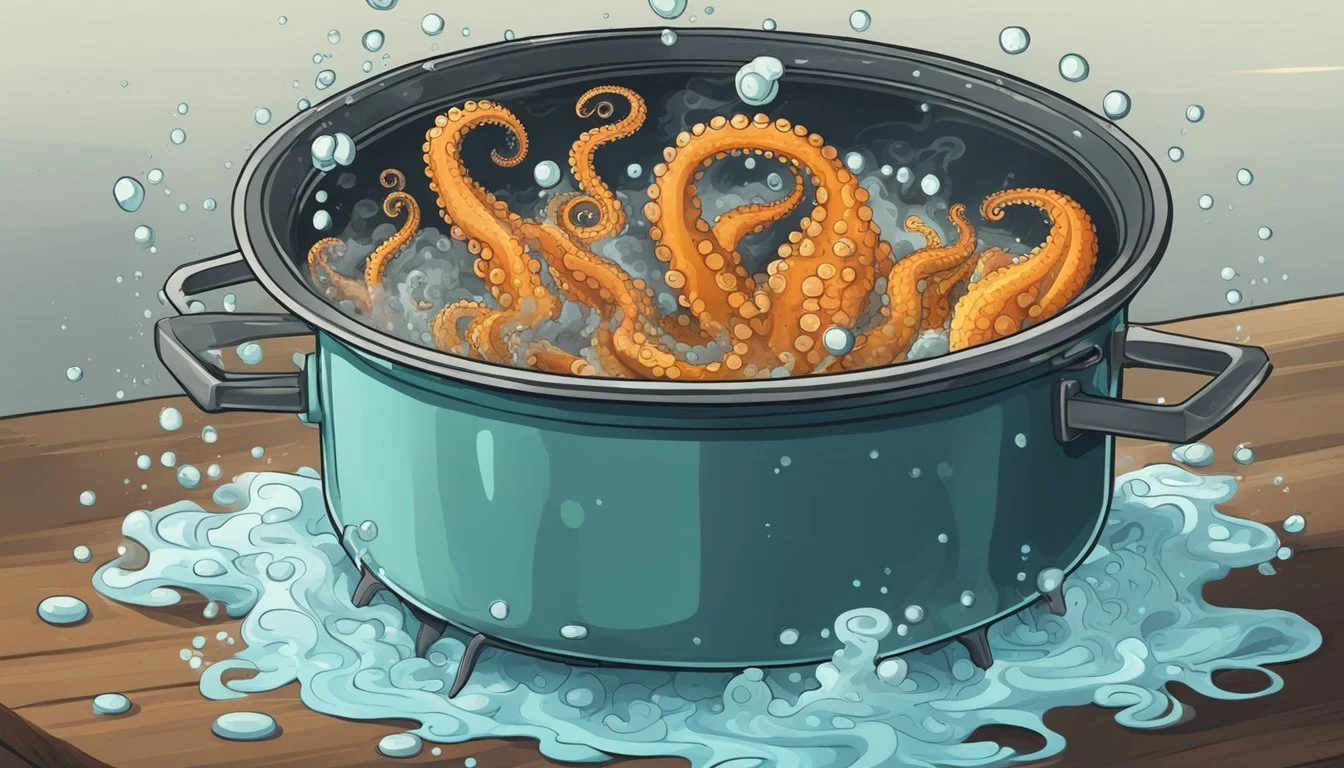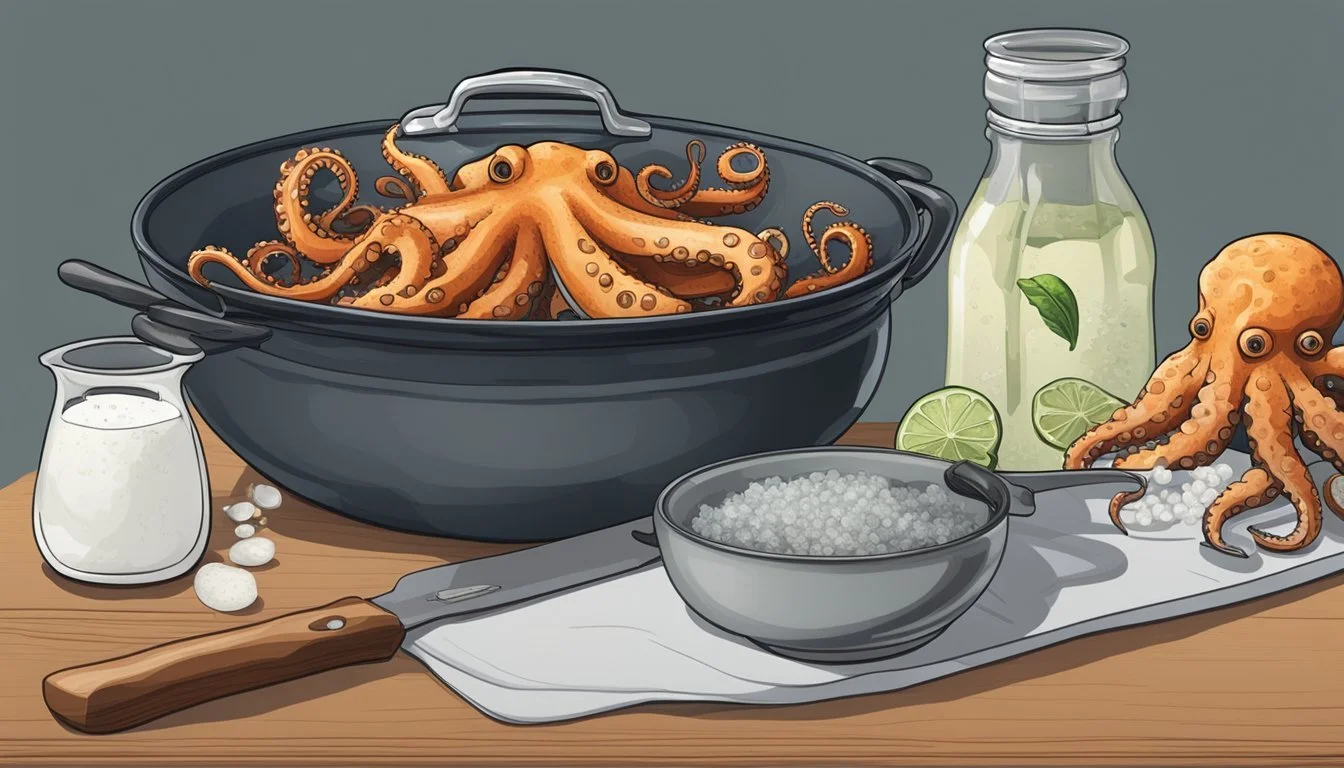Tender Tentacles
Mastering the Art of Cooking Octopus
Octopus, a versatile cephalopod, offers a unique culinary experience for adventurous seafood lovers. Its tender texture and mild flavor make it a prized ingredient in many cuisines around the world. To achieve the perfect tender octopus, cooks can choose from various methods such as boiling, sous vide, or pressure cooking, with each technique yielding slightly different results.
Preparing octopus may seem daunting, but with the right approach, it can be simple and rewarding. Before cooking, it's essential to clean the octopus properly, removing the beak, eyes, and ink sac. The cooking process itself requires patience, as octopus needs time to break down its connective tissues and become tender.
When cooked correctly, octopus can be served in numerous ways. It's excellent cold in salads or ceviche, grilled for a crispy exterior, or seared in a skillet for a balance of textures. Octopus is also nutritious, providing a good source of protein and essential minerals, making it a healthy addition to a balanced diet.
Selecting Quality Octopus
Choosing the right octopus is crucial for achieving a delicious dish. Freshness, texture, and proper preparation all play important roles in selecting quality octopus for cooking.
Frozen vs. Fresh Octopus
Frozen octopus is widely available and often preferred by chefs. The freezing process helps tenderize the meat naturally. When purchasing frozen octopus, look for vacuum-sealed packages without ice crystals or freezer burn. Thaw frozen octopus slowly in the refrigerator for best results.
Fresh octopus can be harder to find but offers a superior flavor. When selecting fresh octopus, check for clear eyes and a fresh sea scent. The skin should be smooth and free from discoloration. Fresh octopus is best used within 24 hours of purchase.
Both frozen and fresh octopus can be used in seafood salads or Mediterranean-inspired dishes. Properly handled, either option can yield tender results when cooked correctly.
Understanding Octopus Anatomy
Octopus consists of several distinct parts, each requiring different preparation:
Head: Contains edible meat but may be tough
Tentacles: The most prized part, rich in flavor and tender when cooked properly
Beak: Inedible, must be removed before cooking
Ink sac: Can be used for flavoring dishes, but is often removed
Suckers: Edible and add texture to the dish
When cleaning octopus, remove the beak and ink sac if present. The head can be stuffed or sliced for various recipes. Tentacles are versatile and can be grilled, braised, or added to salads. Proper cleaning and preparation ensure the best taste and texture in the final dish.
Preparing Octopus for Cooking
Proper preparation is crucial for achieving tender, flavorful octopus. This involves cleaning the octopus thoroughly and employing techniques to break down its tough muscle fibers.
Cleaning and Tenderizing
Start by rinsing the octopus under cold water to remove any debris. Use kitchen shears to cut out the beak, located at the center of the tentacles. Remove the innards from the head cavity and discard them.
To tenderize the octopus, there are several methods. One traditional technique involves beating the octopus with a meat mallet to break down the collagen fibers. Another method is freezing the octopus for at least 24 hours, which helps break down the muscle fibers.
Some chefs swear by adding a wine cork to the cooking liquid, claiming it helps tenderize the meat. While scientific evidence is lacking, this practice remains popular in some culinary circles.
Cutting and Dividing Parts
After cleaning and tenderizing, separate the tentacles from the head using a sharp knife. Cut the head into rings or strips, depending on your recipe requirements.
The tentacles can be left whole or divided into smaller sections. For even cooking, try to cut the tentacles into pieces of similar size.
Remove the thin outer skin if desired, though many prefer to leave it on for added texture and flavor. If removing, blanch the octopus briefly in boiling water, then peel off the skin under cold running water.
For added flavor, consider marinating the octopus pieces in olive oil, lemon juice, garlic, and herbs like parsley before cooking. This step enhances the taste and further tenderizes the meat.
Cooking Techniques for Octopus
Octopus can be prepared using various methods to achieve tender, flavorful results. The key is to tenderize the meat while preserving its unique texture and taste.
Boiling for Tenderness
Boiling is a popular method for cooking octopus. Start by cleaning the octopus thoroughly, removing the beak and ink sac. Fill a large pot with water and add salt. Some chefs add a wine cork to the water, believing it helps tenderize the meat.
Bring the water to a boil and carefully lower the octopus into the pot. Reduce heat and simmer for 45-60 minutes, depending on size. To test doneness, pierce the thickest part with a knife - it should slide in easily.
Once tender, remove the octopus and let it cool. The skin can be left on or peeled off. Slice the tentacles and serve chilled in salads or use in other recipes.
Grilling for Flavor
Grilling octopus imparts a smoky flavor and crispy texture. Pre-cook the octopus by boiling or simmering until tender. Pat dry and brush with olive oil. Heat the grill to medium-high.
Place octopus on the grill for 3-4 minutes per side. The tentacles will curl and develop char marks. Don't overcook, as it can become tough.
For added flavor, marinate the pre-cooked octopus in lemon juice, olive oil, and herbs before grilling. Serve hot with a drizzle of high-quality olive oil and a sprinkle of sea salt.
Simmering with Aromatics
Simmering octopus with aromatics infuses it with rich flavors. In a large pot, combine water or stock with ingredients like white wine, bay leaves, peppercorns, and garlic.
Bring the liquid to a simmer and add the cleaned octopus. Cook gently for 45-60 minutes until tender. The low, steady heat helps break down the connective tissues.
Once cooked, remove the octopus and let it cool slightly. Slice and serve warm, or chill for later use. The cooking liquid can be strained and reduced to create a flavorful sauce.
Finishing Techniques and Plating
Mastering the final steps of octopus preparation elevates the dish from good to exceptional. Proper finishing techniques ensure the perfect texture, while thoughtful plating enhances visual appeal and flavor combinations.
Achieving the Perfect Texture
Grilling is a popular method to finish octopus. Brush the pre-cooked tentacles with olive oil and place them on a hot grill for 2-3 minutes per side. This creates a crispy exterior while maintaining tenderness inside.
For a charred flavor, try the alla Karvouna technique. Heat a cast-iron skillet until smoking, then sear the octopus for 1-2 minutes per side. This method yields a delightful contrast between the crispy exterior and soft interior.
Pan-searing is another effective option. Heat olive oil in a skillet over medium-high heat. Cook the octopus for 2-3 minutes on each side until golden brown. This technique works well for smaller pieces or sliced tentacles.
Sauces and Seasoning
A simple lemon and olive oil dressing complements the octopus' natural flavors. Mix fresh lemon juice, extra virgin olive oil, and finely chopped oregano. Drizzle over the plated octopus just before serving.
For a Mediterranean twist, create a quick tomato sauce. Sauté diced tomatoes with garlic, olive oil, and a pinch of sea salt. Simmer until slightly thickened, then spoon over the octopus.
Sprinkle coarse sea salt and freshly ground black pepper over the finished octopus to enhance its natural taste. For added depth, incorporate smoked paprika or crushed red pepper flakes into the seasoning mix.
Wine Pairing and Accompaniments
Choosing the right wine and side dishes enhances the octopus dining experience. Proper pairings complement the unique flavors and textures of this seafood delicacy.
Selecting Wines
Light to medium-bodied wines work best with octopus. White wines like Sauvignon Blanc and Pinot Grigio offer crisp acidity that cuts through the richness of the pulpo.
For red wine lovers, lighter-style Grenache or Tempranillo provide a good match. These wines have enough body to stand up to grilled octopus without overpowering it.
Mediterranean wines are particularly suitable. A Greek Assyrtiko or Spanish Albariño can beautifully complement octopus dishes.
When serving octopus with tomato-based sauces, try a Chianti or other Italian red. The acidity in these wines balances the tartness of the tomatoes.
Complementary Side Dishes
Boiled potatoes are a classic accompaniment to octopus. Their mild flavor and creamy texture contrast nicely with the firm, slightly chewy octopus.
A fresh green salad with a lemon vinaigrette adds brightness and balances the richness of the dish. Consider adding peppery arugula or bitter radicchio for complexity.
Grilled vegetables like zucchini, eggplant, or bell peppers make excellent sides. Their smoky flavor complements grilled octopus particularly well.
For a starch option, crusty bread is ideal for soaking up any leftover juices or olive oil. A simple garlic bread can add extra flavor without overshadowing the octopus.
Lemon wedges are essential. A squeeze of fresh lemon juice brightens the flavors and enhances the overall dish.
Serving and Presentation Tips
Grilled octopus is best served immediately after cooking. Place it on a warmed platter to maintain its temperature.
Drizzle high-quality olive oil over the octopus for added flavor and a glossy appearance. A squeeze of fresh lemon juice brightens the dish.
Garnish with chopped fresh parsley to add color and a subtle herbal note. Sprinkle sea salt flakes for texture and enhanced taste.
Consider serving the octopus with lemon wedges on the side. This allows diners to adjust the acidity to their preference.
For a rustic presentation, serve the octopus directly on a wooden board. Alternatively, use white plates to create a striking contrast with the charred tentacles.
Pair grilled octopus with simple sides like roasted potatoes or a crisp Greek salad. This keeps the focus on the star of the dish.
When handling hot octopus, use tongs to avoid burns and maintain a neat presentation. Avoid cutting the tentacles too small, as larger pieces are more visually appealing.
For a family-style meal, place the whole grilled octopus in the center of the table. Provide small plates and allow guests to serve themselves.
Consider garnishing with aromatics like thinly sliced garlic or fresh herbs to enhance the visual appeal and aroma of the dish.
Storage and Leftovers
Proper storage is crucial for maintaining the quality of cooked octopus. After cooking, allow the octopus to cool completely before refrigerating. Place it in an airtight container or wrap tightly in aluminum foil.
Refrigerated octopus will stay fresh for up to 2 days. For longer storage, freezing is an excellent option. Wrap individual portions in plastic wrap, then aluminum foil before placing in freezer bags.
Frozen octopus can last up to 3 months. To thaw, transfer from the freezer to the refrigerator overnight. Avoid thawing at room temperature to prevent bacterial growth.
Leftover octopus can be enjoyed cold in salads or quickly reheated. To reheat, place in a covered dish with a splash of water and warm gently in the microwave or oven until just heated through.
When reheating, be careful not to overcook as this can make the octopus tough. Aim to warm it just enough to enjoy, preserving its tender texture.
Always check for any signs of spoilage before consuming leftover octopus. If it has an off odor or appearance, it's best to discard it for safety.
Health and Nutrition
Octopus is a nutritious seafood option that offers several health benefits. A 3-ounce (85-gram) serving of cooked octopus contains approximately 139 calories and 25 grams of protein.
This marine delicacy is low in fat, with only 1.8 grams per serving. It's also a good source of essential vitamins and minerals, including vitamin B12, selenium, iron, and copper.
Octopus is rich in collagen, a protein that supports skin health and may help reduce joint pain. Its high protein content can aid in muscle growth and repair.
As part of the Mediterranean diet, octopus contributes to heart health due to its omega-3 fatty acids content. These healthy fats may help reduce inflammation and lower triglyceride levels.
Nutrition facts for a 3-ounce serving of cooked octopus:
Calories: 139
Protein: 25g
Fat: 1.8g
Carbohydrates: 3.7g
Fiber: 0g
Sugar: 0g
Octopus is particularly beneficial for those seeking a lean protein source. Its low calorie and fat content make it suitable for weight management diets.
When preparing octopus, consider healthier cooking methods like boiling, braising, or grilling to maintain its nutritional value. Avoid frying or cooking in excessive oil, which can increase calorie and fat content.
Alternate Octopus Dishes
Octopus lends itself to diverse culinary applications beyond traditional preparations. Creative chefs explore new ways to showcase this versatile seafood in salads and sushi.
Creating a Seafood Salad
Octopus makes an excellent addition to seafood salads. Thinly sliced cooked tentacles add a tender texture and subtle flavor. Combine them with other seafood like shrimp, calamari, or crab meat.
For a Mediterranean-inspired dish, mix octopus with diced tomatoes, red onions, and olives. Dress with lemon juice and olive oil. Season with fresh herbs like parsley or oregano.
A green salad gains protein and interest with the addition of grilled octopus pieces. Toss with mixed greens, cucumber, and a light vinaigrette. Crumbled feta cheese complements the octopus well.
Innovative Sushi Options
Sushi chefs incorporate octopus into creative rolls and nigiri. Tako (octopus) nigiri features a thin slice of cooked octopus atop seasoned rice. The chewy texture contrasts nicely with the soft rice.
For rolls, combine thin strips of octopus with cucumber or avocado. A spicy mayo or eel sauce adds flavor. Torched octopus nigiri offers a smoky twist on the classic preparation.
Experiment with seasoning octopus for sushi. Try a light marinade of soy sauce, mirin, and ginger before serving. Or brush with a sweet teriyaki glaze for added depth.
Essential Cooking Tools
Kitchen shears are indispensable when preparing octopus. They allow for precise cutting of tentacles and removal of the beak and innards.
A sturdy fork is useful for testing the octopus's tenderness during cooking. Insert it into the thickest part to check for doneness.
A large baking sheet lined with aluminum foil provides an ideal surface for drying and preparing the octopus before cooking. It also makes cleanup easier.
Tongs are essential for handling hot octopus safely. They provide a secure grip when transferring the octopus in and out of cooking vessels.
A heavy-bottomed pot or pressure cooker is necessary for simmering or pressure-cooking octopus to achieve tender results.
A sharp knife complements kitchen shears for additional trimming and portioning of the cooked octopus.
A cutting board with a juice groove helps contain any liquids released during preparation and cutting.
For grilling octopus, a grill basket prevents smaller tentacles from falling through the grates.
A meat thermometer can be helpful to ensure the octopus reaches a safe internal temperature, typically around 140°F (60°C).






